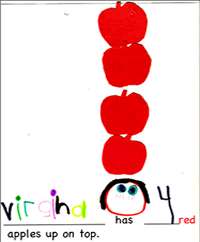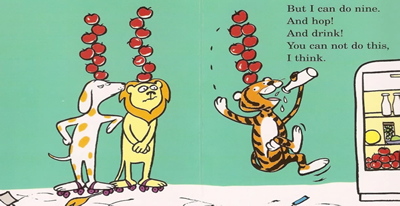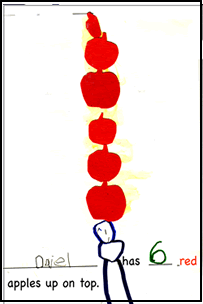Connecting math and literature enhances students’ mathematical understanding. “Ten Apples Up On Top”, by Theo. Le Sieg’s (Dr. Suess) is not only a fun story, it also helps students practice counting and increases number sense.
This is a terrific story about animals balancing apples on their heads. It’s funny and children love it. The characters become quite competitive as the story progresses and the dilemma is solved by the end. It also contains lots of rhyming words.
Day 1
Read the whole story and have fun with it. Let those students who want to comment on the story, do so. Keep the conversation focused on the book and not too long or you will lose the children’s attention. Leave the story on display so that children can look at it more closely.

Day 2 – Review the book. Look at the picture on the cover and at some of the inside pictures. Talk about who wrote the story and drew the pictures. Before teaching any math with “Ten Apples Up On Top!”, encourage the students to think about the story and ask questions.
A few topics/activities to instigate discussions (choose a few):
- Talk about balancing things on heads
- Show a few pictures of people from other cultures who carry items by balancing them on their heads. Talk about why.
- Try balancing pencils on fingers
- Let the students try walking with a book on their heads
- Put balancing toys in the science experiment center

Day 3 – Reread “Ten Apples Up On Top!”. This time stop and count apples on some of the pages. Use terms more than, fewer than, large, larger, largest.
Day 4 – Make a class book based on the story and call it “We Have Apples Up on Top”
Materials:
- Glue
- Felt markers
- 8.5 x 11 lightweight card with words photocopied or glued on,
one per child and extras
______________ has __________ red apples up on top. - About 4 – 7 cut out one-inch apples per child. Fold red paper and cut out lots at a time, they don’t have to be perfect.
- Red construction paper for children who want to cut out more apples or smaller apples.
Procedure:
- Print your name on the first line with bright colored felts.
- Draw a small picture of yourself or just your head right above the sentence.
- Glue some apples on top of the head picture.
- Count apples
- Print the number on the second line.Read the sentence to the class. Count the apples.
Open-ended Activity
This is a great open-ended activity and all students can experience success. One child might glue on three apples and need help to count and print, while another may draw two heads, put apples on both, print how many apples on each head and how many all together.
Modeling the activity
For the “Ten Apples Up On Top!” activity, I make the first letter of my name so big I can’t fit the rest on the line. I then draw myself too big and have no room to glue the apples on my head. The kids find it funny and it makes them aware of what could go wrong.
- Have extra pages if a child is unhappy with his/her results and wants to try again.
- As this apple investigation is usually done earlier in the school year, September and October, students may need help printing their names, counting, or printing numbers.
Class Book
- Assemble the pages into a class book with a large metal ring in the top corner.
- The children love hearing their page read over and over.
- Keep the new class book beside the actual book, “Ten Apples Up On Top!” and the kids can read both.
